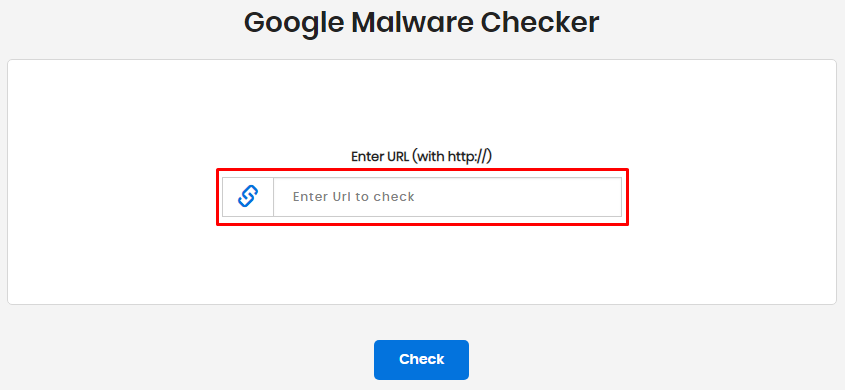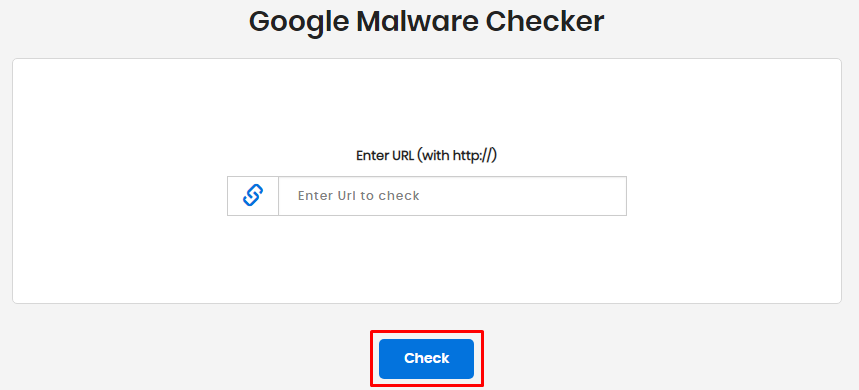Google Malware Checker
Check if your website is infected with malware with the assistance of our Google malware checker. Write or paste the URL in the field, located inside the tool and tap on the "Check" button.
When we are talking about internet security, it has become a rudimentary necessity of every website that wants to progress up the SERP. If you wish to avoid any security risks, then you are on the right page! This is where you will be informed about how well your website is doing on the internet and are there any risks involved in promoting the content or not. There are a number of factors that you need to put under consideration before, pushing the content of your website.
Today, most of the people who are connected to the internet are using different tactics to affect various URLs. In the end, sites that are pretentious will require a malware removal tool, which is not easy to look for, but you can reinstate your website if something like this occurs in the future. Also, it’s not only the sites that get malware, but it’s also the computers as well. People can gain control over your machines, thus resulting in loss of the excess amount of data, which can include your personal details as well. Such circumstances can be avoided if you start taking precautionary measures right now.
The internet has become the most crucial part of everyone’s lives. People find the answer to most of the queries in the SERP, along with all sorts of services and products. People will diminish the use of the internet if websites begin getting infected with viruses because that is also one of today’s significant reason behind computer viruses. We usually install antivirus software in the computer to prevent viruses from affecting the files in other areas. Similarly, Google Malware check tool can inform you which area of your website is malicious.
Whenever a computer begins to get slow in opening applications or reading media from storage, our first suspicion is maybe we are running out of random access memory (RAM). When you don’t have any common intercepting problems, then it’s the moment of certainty that it is all due to a virus. Commonly there are two types of malware located on the web that get downloaded due to our lack of knowledge.
We download files sometimes which we just read about over the internet, and in them, our computer finds commands that it has to follow. You can scan a website for malware before downloading any type of content, and the most common way through which a computer gets malware is:
- Contacts on Social Media & Phishing Websites
This is where people use psychological methods to reach the weak spot of a person and make him/her download the content from an external link. These ways were quite common, but Google took severe actions against phishing websites that were collecting information from people. A virus can be used either to destroy the data one has or to copy it without leaving a trace, though today’s file types are traceable.
The phishing sites are used to gather information for a particular domain. People used to develop websites that exactly looked like other platforms with just a small change in their URL. It enabled them to gather information either by luring them into a misleading trap or by just letting them know it’s another version try it out, etc.
How exactly malware affects a website? Well, it can either change the looks of your site, or can ultimately bring it down by spreading through advertisements, emails, redirects, and more.
Most of the times, the first thing that happens when a website gets affected with malware is the change in its appearance. Defacement is a method applied by defacers to change the looks of a page or site by breaching into the servers and replacing the files. It not only alters the looks but also doesn’t let its current users check their data. It is like the host is installed with an entirely new website.
After that, comes the ones hidden in advertisements which cannot be downloaded unless you click and try to play them. Most of the internet users get affected by this type of virus, where a user after opening the ad gets redirected to a new page, where an automatic download begins which is either an EXE file or a couple of codes in batch.
Some sites contain spam content this type of websites does not contain malware, but for sure they face a significant loss in search engine ranking systems. Google take strict actions against such sites, plus a person connected to cyber activities can generate backlinks to your website and place them on various malicious links which can cause trouble for your reputation.
This can also become a reason for such downfalls in rank, make sure you keep an eye on the websites you are connected with because backlinks hold vital importance and are the most practiced skill in SEO. You can utilize the facilities of our malware testing Google test tool to find the location of the virus and remove instantly if you have the knowledge of back end development.
There are several weak spots on websites that people who are not in the field of development fail to cover. You need to install security patches and keep them updated, and in case a site is developed in content management system like WordPress, they come with fixed plugins that take care of your website.
Furthermore, if your site is not developed in a CMS, then you need to be very wise in selecting plugins to install. You can use our tool to check the site for malware before building an inbound link or embedding any tools of other websites. Follow the guide given below to scan sites for malware and begin generating more links.
To use the tool, a few simple steps are involved:
- On the page of Google Malware Checker, you will find an address bar. This is where you will be providing the link of the site you want to scan.
- When you are done with typing or pasting the URL in the “Enter URL,” all you have to do is press the “Check” button, and you will be presented with results in a matter of seconds.






